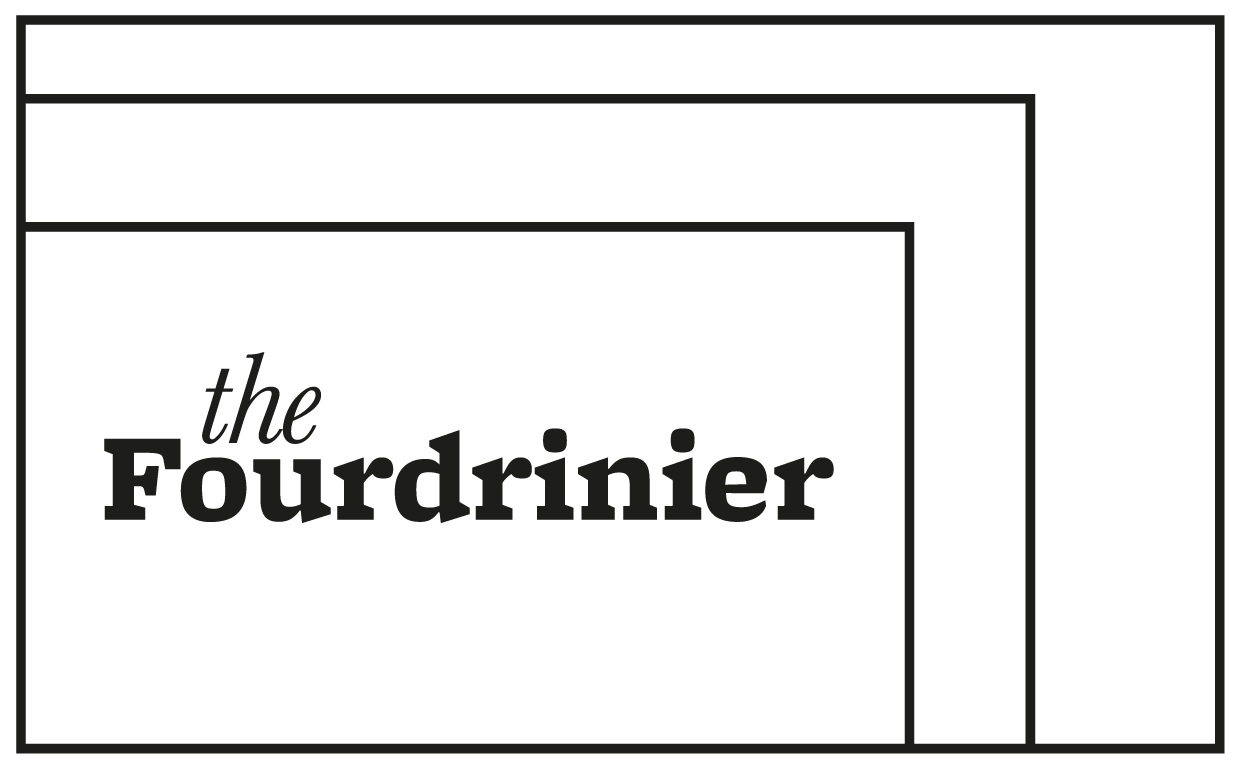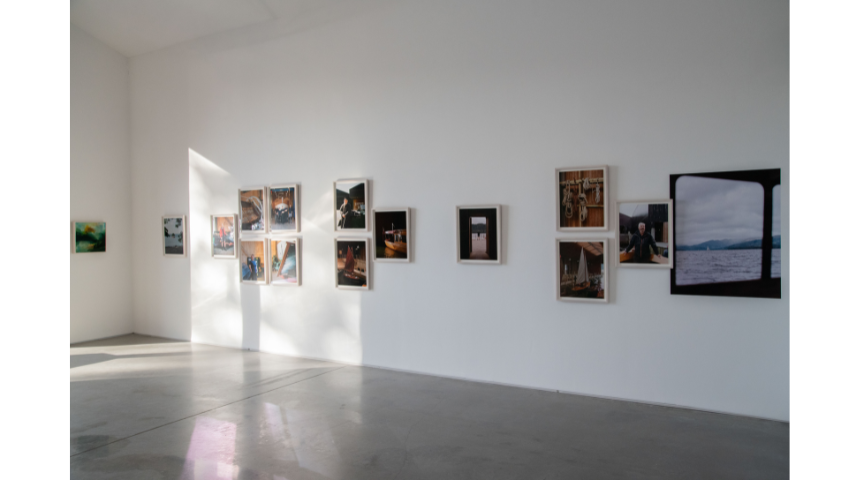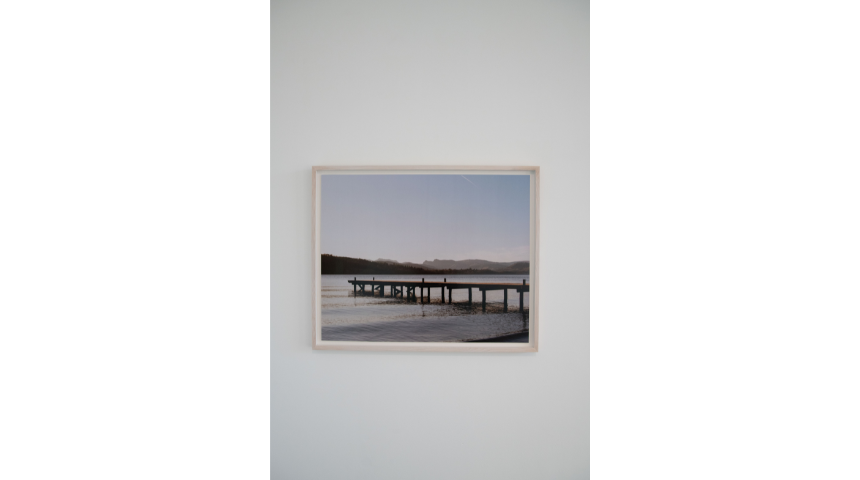INTERVIEW Nov 2025 ‘Juliet Klottrup: An Archive’ at Windermere Jetty Museum
Kirsty Jukes
Juliet Klottrup, installation shot ‘An Archive’ at Windermere Jetty Museum, © Juliet Klottrup
Art historian and writer Kirsty Jukes interviews Juliet Klottrup about her work and practice after the launch of ‘An Archive’ at Windermere Jetty Museum, Bowness-on-Windermere. This solo exhibition is both a celebration and a preservation, acting as a living record of Windermere Jetty Museum’s people, history, and environment in 2025. Deeply rooted in place, this mixed media exhibition is visually intriguing and emotionally resonant. Throughout this ‘living archive’, visitors can expect to see snapshots of community events, local heritage and lakeside life created by an award-winning artist born and raised in the region. ‘Juliet Klottrup: An Archive’ is on view until Sunday 31 May 2026.
“This project grows from my lifelong connection to the lake and my ongoing commitment to photographing Cumbria.” (1)
From outside, the collection of Windermere Jetty Museum buildings evokes that very Danish feeling of Hygge (pronounced ‘hooga’). There is a certain cosiness to be felt from a cluster of pitched roof shelters nestled by the water and treeline that makes me want to head straight inside from the autumn chill. By giving each building a modern shape made from natural materials, the traditional craftsmanship of boatbuilding housed therein is propelled into the present day. Once inside, visitors are encased in warm wooden slats that echo the hull of a newly built boat. Chestnut brown boards echo the golden leaf senescence of the foliage outside in a way that is very pleasing to me, like being encased in a blob of amber. The satisfying nature of this beautiful gallery space continues inside as I make my way into Juliet Klottrup’s vibrant display, ‘An Archive’.
Along the walls are clustered collections of photographic prints and paintings thoughtfully hung by theme. What struck me first about Klottrup’s work was the clear joy and love she has for her community, evident in both her artistry and the feeling she draws from the people she has photographed. Her works focus on the people of Windermere, the surrounding landscape and details of everyday life that make this area so unique. Framing each snapshot as she does places me directly in dialogue with the sitter and everyday objects related to their experience.
This feels intimate in the way that fellow photographers Shirley Baker and Martin Parr are known for. Klottrup’s eye is sympathetically personable, an important trait for an artist wanting to present the personality of locals with care. Each of the accompanying paintings adds further depth to the display by drawing on water as the element that binds this community together. Washes of blue and green are like the shimmering surface of the lake. Combined with blushing pinks, sunny yellows and earthy browns, these painted works are a vessel for the wider narrative of Klottrup’s love of the lakeside.
Throughout the display, light played off the water outside to flicker across the walls in a way that further connected Klottrup’s work to its wider environment. Glimpses of my surroundings in between sets of artworks instilled a sense of place so central to this exhibition, it is difficult to imagine it being better housed anywhere else than on Windermere.
Seeing an exhibition in this way also made the viewer in me focus on the environmental concerns of rural communities, almost as if the land around me was reminding me not to forget. This is an exhibition focused firstly on the landscape and the feelings this invokes in the artist, visiting viewers and inhabitants. Secondly, it is focused on people and how they live their lives in an environment unique to the area via the lens of a woman who clearly cares so much about them. It is both fascinating and moving to see. Klottrup was kind enough to speak with me about her background, artistic practice and the making of her solo exhibition for the following interview.
Juliet Klottrup, installation shot ‘An Archive’ at Windermere Jetty Museum, © Juliet Klottrup
Kirsty Jukes: ‘An Archive’ incorporates archive material alongside work you have created. Can you tell me more about your process and how being a curator as well as an artist influenced the outcomes of this project?
Juliet Klottrup: The Windermere Jetty Museum’s archive was the starting point for this project – a record of work, leisure and community over time, from 19th-century swimmers to scenes of lake life and physical artefacts. Immersing myself in these materials, I began to see how the same rhythms and characters still shape the place today. With an open brief, I set out to create a dialogue between past and present, using the archive as both inspiration and anchor for new work.
Time spent with the collection, along the shoreline, and within local communities revealed how The Jetty continues to act as a living thread – where everyday life and restoration efforts keep history alive. Bringing my responses together, I shaped a portrait of place – exploring work, connection, and leisure. I also created paintings in direct response to that intangible, hard-to-describe feeling of what it means to connect with water.
KJ: What was your favourite part of creating 'An Archive’?
JK: I so enjoyed making work about a place I love so much and have always known. I know others feel as deeply and with a sense of ownership and care for a place. The feeling of what it means to return ‘Home’ is how I feel towards the land I record.
Someone recently pointed out that the images I make about others also reveal something of myself, and I think that’s true. Each photograph is a collaboration – part them, part me – and through this project, we’re all connected by the landscape of the North.
KJ: There is a proud working-classness present across many of the images on display. In your opinion, is the story of a place entangled in the experiences of local workers and tradespeople? Furthermore, how can organisations follow Lakeland’s example in fore fronting their experiences in cultural institutions?
JK: The story of a place is inseparable from the lives of the people who work and build within it. There’s huge value in highlighting local voices, framing the everyday and seemingly ordinary into a portrait that feels significant – showing that people and their moments are important and seen. I enjoy this aspect of my work so much because art and culture should be accessible and reflect everyone. Many of the people I’ve met through my work are local, and their daily lives form the living story of the place. You can find interesting stories and people anywhere if you take the time to look. Taking a minute to appreciate these ‘villages’ and their worlds helps everyone feel more connected to the place and understand it better. I think it’s important to collaborate directly with local communities to share their experiences and co-create projects. This helps cultural institutions celebrate everyday life and strengthen people’s connection to where they live.
KJ: Local histories can be deeply enmeshed in nostalgia and memory, both of which enable unique local identities to form. Can you tell me what you feel makes people uniquely Cumbrian?
JK: Cumbria is vast, and the lived experiences across the region are strikingly different – from the South Lakes to the western coast and deep into the fells, each person’s sense of ‘home’ feels unique. This diversity of landscape shapes equally distinctive identities. What both unites and separates these communities is, in many ways, the landscape itself – it influences how people live, work, and connect. As a photographer and artist, I use my lens to let people reveal those identities for themselves, capturing how lives and landscapes are deeply intertwined across this expansive county.
Juliet Klottrup, installation shot ‘An Archive’ at Windermere Jetty Museum, © Juliet Klottrup
KJ: Capturing the best photographs involves a certain level of trust between photographer and subject. How do you achieve such a level of intimacy between both parties in your work?
JK: Everything starts with conversation. I never underestimate the intimacy of capturing someone’s portrait. The best portraits are collaborative, when we decide together what to capture, where and why. Shooting analogue across still images means there is slowness to my process of documenting that always allows for more time together. The images will outlive us all so I really take care in making them.
KJ: As film media such as photography and video continue to take up more wall space in artistic institutions, what advice do you have for photographers and videographers looking to gain recognition in this way?
JK: I think making work that you enjoy is important. The act of interpreting the world through art can feel deeply personal, yet when it resonates with others, it reveals how closely our experiences are woven together.
KJ: Your project work involves many references to counter culture movements such as marginalised British skating communities and attendees of Whitby Goth Festival. How did you employ lessons learned from these projects in capturing the youth in the area around Windermere Jetty?
JK: I’m drawn to communities that exist outside mainstream narratives and seek to collaborate in sharing the often untold stories within these rich and distinctive cultures. What excited me about photographing young people around Windermere Jetty was seeing their “backyard” not as a garden, but as this vast lake – a space to explore after school or at the weekend. This incredible access to nature is the backdrop to their downtime, shaping the way they express themselves and interact with their surroundings, much like the communities I’ve worked with in previous projects.
KJ: You are acclaimed for your photography and film work. In this project, you have also created your own beautiful paintings using colours from the archive. How easy was it for you to move between media for this exhibition?
JK: I originally studied illustration as my degree, so painting has always been a part of my process – a way to explore abstraction. My lens-based work feels more like observation and ‘truth’, while painting lets me blur and play with expression. Sometimes I’m restless to go beyond where the photographs end, so that’s where paintings begin.
The colours for these pieces are rooted in ‘truth’ swatched directly from the archive: the painted boats, weathered wood, colour from 8mm home videos, and faded flags and buoys, turning real details into abstract impressions of place and experience.
Juliet Klottrup, installation shot ‘An Archive’ at Windermere Jetty Museum, © Juliet Klottrup
KJ: Water can act as a calming influence on the mind, with bodies of water in particular drawing people to their shores from far around. In what way are you connected to Windermere Lake and how do its waters influence your everyday life?
JK: I’ve always felt deeply connected to Windermere. Before I could even walk, my family would come here for days by the water and over time, it’s become a constant presence in my life. Now, as an adult, the lake is a place of refuge where I come for nostalgia, reflection, and downtime. Returning to a place filled with so much personal history and making it part of my work feels very natural. This project is rooted in that lifelong connection to the lake and in my ongoing commitment to photographing Cumbria.
KJ: Across the entire exhibition are images of hope, unity and a contented sense of place. What do you see in Cumbria’s future and for the communities who live here?
JK: I hope for resilience for heritage and culture to endure in a changing world. Through my work, I aim to capture the present while reflecting on the future, documenting the strength of often-overlooked hyperlocal communities, the importance of conservation, and the enduring spirit of local heritage. With so much land mass, I hope the future continues to prioritise living with nature, not against it.
‘Juliet Klottrup: An Archive’ runs until Sunday 31 May 2026 at Windermere Jetty Museum.
Entry included with museum admission. Lakeland Arts members and Annual Pass holders go free. Pre-book tickets online here.
This interview is supported by Lakeland Arts.
Footnotes:
(1) Juliet Klottrup quote taken from ‘An Archive’ exhibition wall panel.
Juliet Klottrup, installation shot ‘An Archive’ at Windermere Jetty Museum, © Juliet Klottrup






